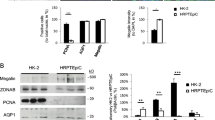Abstract
Purpose. Madin Darby Canine Kidney (MDCK) cells were grown in culture, and age-related morphological changes in the cytoskeleton and tight junction (TJ) network were used to define stages in view of establishing an optimal in vitro model for the epithelial barrier.
Methods. Growth curves and transepithelial electrical resistance (TEER) were determined, and the cytoskeleton (actin, α-tubulin, vimentin) and TJ (Zonula occludens proteins ZO1, ZO2) were investigated with immunofluorescent methods by confocal laser scanning microscopy (CLSM) and digital image restoration.
Results. TEER measurements indicated that TJ were functional after one day. Values then remained constant. Four morphological stages could be distinguished. Stage I (0−1 day): Sub confluent cultures with flat cells; TJ established after cell-to-cell contacts are made. Stage II (2−6 days): Confluent monolayers with a complete TJ network, which remains intact throughout the later stages. Stage III (7−14 days): Rearrangement in the cytoskeleton; constant cell number; volume and surface area of cells reduced (cobble-stone appearance). Stage IV (≥ 15 days): Dome formation, i.e. thickening and spontaneous uplifting of the cell monolayer.
Conclusions. Based on the structural characteristics of stage III cell cultures, which are closest to the in vivo situation, we expect them to represent an optimal in vitromodel to study drug transport and/or interactions with drugs and excipients.
Similar content being viewed by others
REFERENCES
K. L. Audus, R. L. Bartel, I. J. Hidalgo, and R. T. Borchardt. The use of cultured epithelial and endothelial cells for drug transport and metabolism studies. Pharm. Res. 7:435–451 (1990).
P. Artursson and R. T. Borchardt. Intestinal drug absorption and metabolism in cell cultures: Caco-2 and beyond. Pharm. Res. 14:1655–1658 (1997).
J. A. McRoberts, M. Taub, and M. H. Saier. The Madin Darby canine kidney (MDCK) cell line. In G. Sato (ed.), Functionally Differentiated Cell Lines. Alan R. Liss, Inc., New York, 1981, pp. 117–139.
B. Gumbiner. Structure, biochemistry, and assembly of epithelial tight junctions. Am. J. Physiol. 253:749–758 (1987).
R. Bacallao, C. Antony, C. Dotti, E. Karsenti, E. H. K. Stelzer, and K. Simons. The subcellular organization of Madin Darby canine kidney cells during the formation of a polarized epithelium. J. Cell Biol. 109:2817–2832 (1989).
S. Eskelinen, V. Huotari, R. Sormunen, R. Palovuori, J. W. Kok, and V.-P. Lehto. Low intracellular pH induces redistribution of fodrin and instabilization of lateral walls in MDCK cells. J. Cell. Physiol. 150:122–133 (1992).
B. Gumbiner and K. Simons. A functional assay for proteins involved in establishing an epithelial occluding barrier: identification of a uvomorulin-like polypeptide. J. Cell Biol. 102:457–468 (1986).
B. Gumbiner, B. Stevenson, and A. Grimaldi. The role of the cell adhesion molecule uvomorulin in the formation and maintenance of the epithelial junctional complex. J. Cell Biol. 107:1575–1587 (1988).
L. Gonzalez-Mariscal, B. Chávez de Ramirez, and M. Cereijido. Tight junction formation in cultured epithelial cells (MDCK). J. Membr. Biol. 86:113–125 (1985).
D. Shotton and N. White. Confocal scanning microscopy: three-dimensional biological imaging. Trends Biochem. Sci. 14:435–439 (1989).
R. C. Gonzalez and P. Wintz. Digital Image Processing, Addison-Wesley Publishing Company, Reading, 1987.
B. M. Rothen-Rutishauser, E. Ehler, E. Perriard, J. M. Messerli, and J.-C. Perriard. Different behaviour of the non-sarcomeric cytoskeleton in neonatal and adult rat cardiomyocytes. J. Mol. Cell. Cardiol. 30:19–31 (1998).
M. Schliwa, J. van Blerkom, and K. R. Porter. Stabilization of the cytoplasmic ground substance in detergent-opened cells and a structural and biochemical analysis of its composition. Proc. Natl. Acad. Sci. USA 78:4329–4333 (1981).
J. E. Lever. Inducers of mammalian cell differentiation stimulate dome formation in a differentiated kidney epithelial cell line (MDCK). Proc. Natl. Acad. Sci. USA 76:1323–1327 (1979).
M. Cereijido, E. S. Robbins, W. J. Dolan, C. A. Rutunno, and D. D. Sabatini. Polarized monolayers formed by epithelial cells on a permeable and translucent support. J. Cell Biol. 77:853–880 (1978).
M. J. Cho, D. P. Thompson, C. T. Cramer, T. J. Vidmar, and J. F. Scieszka. The Madin Darby canine kidney (MDCK) epithelial cell monolayer as a model cellular transport barrier. Pharm. Res. 6:71–77 (1989).
C. Butor and J. Davoust. Apical to basolateral surface area ratio and polarity of MDCK cells grown on different supports. Exp. Cell Res. 203:115–127 (1992).
F. Cao and J. M. Burke. Protein insolubility and late-stage morphogenesis on long-term postconfluent cultures of MDCK epithelial cells. Biochem. Biophys. Res. Comm. 234:719–728 (1997).
J. D. Valentich. Morphological similarities between the dog kidney cell line MDCK and the mammalian cortical collecting tubule. Ann. N. Y. Acad. Sci. 372:384–405 (1981).
M. G. Farquhar and G. E. Palade. Junctional complexes in various epithelia. J. Cell Biol. 17:375–412 (1963).
L. A. Jesaitis and D. A. Goodenough. Molecular characterization and tissue distribution of ZO-2, a tight junction protein homologous to ZO-1 and the Drosophila discs-large tumor supressor protein. J. Cell Biol. 124:949–961 (1994).
J. E. Lever. Variant (MDCK) kidney epithelial cells altered in response to inducers of dome formation and differentiation. J. Cell Physiol. 122:45–52 (1985).
M. M. Jaeger, V. Dodane, and B. Kachar. Modulation of tight junction morphology and permeability by an epithelial factor. J. Membr. Biol. 139:41–48 (1994).
Author information
Authors and Affiliations
Rights and permissions
About this article
Cite this article
Rothen-Rutishauser, B., Krämer, S.D., Braun, A. et al. MDCK Cell Cultures as an Epithelial In Vitro Model: Cytoskeleton and Tight Junctions as Indicators for the Definition of Age-Related Stages by Confocal Microscopy. Pharm Res 15, 964–971 (1998). https://doi.org/10.1023/A:1011953405272
Issue Date:
DOI: https://doi.org/10.1023/A:1011953405272




